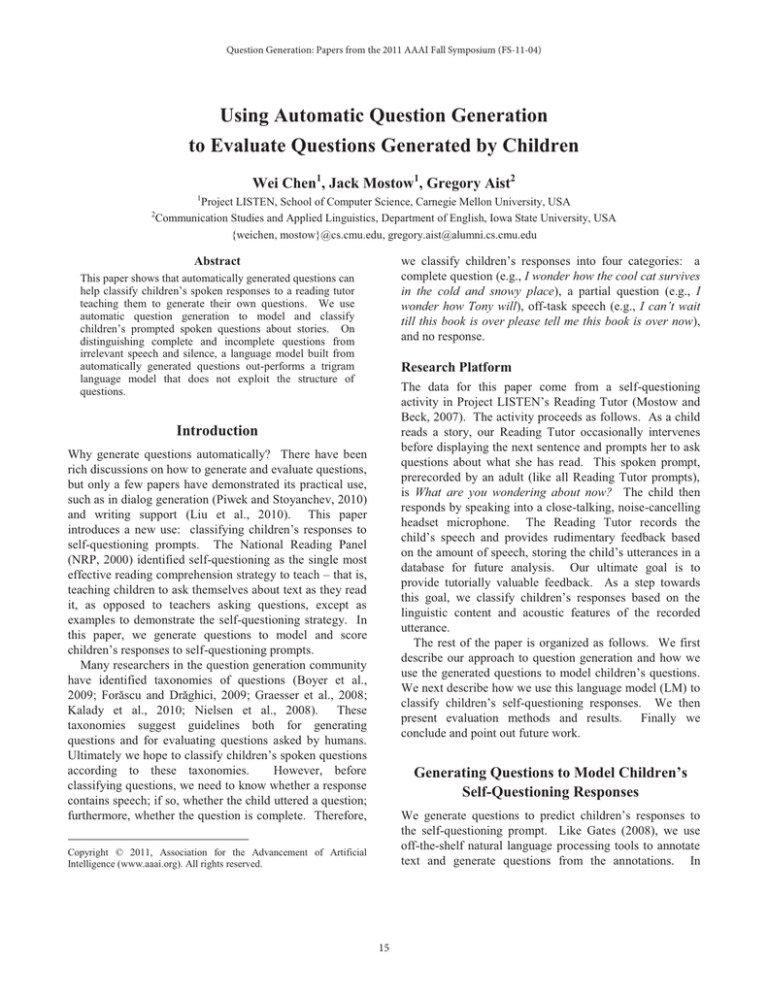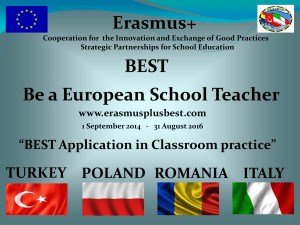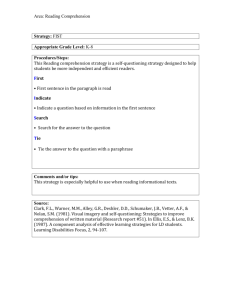
Question Generation: Papers from the 2011 AAAI Fall Symposium (FS-11-04)
Using Automatic Question Generation
to Evaluate Questions Generated by Children
Wei Chen1, Jack Mostow1, Gregory Aist2
1
Project LISTEN, School of Computer Science, Carnegie Mellon University, USA
Communication Studies and Applied Linguistics, Department of English, Iowa State University, USA
{weichen, mostow}@cs.cmu.edu, gregory.aist@alumni.cs.cmu.edu
2
we classify children’s responses into four categories: a
complete question (e.g., I wonder how the cool cat survives
in the cold and snowy place), a partial question (e.g., I
wonder how Tony will), off-task speech (e.g., I can’t wait
till this book is over please tell me this book is over now),
and no response.
Abstract
This paper shows that automatically generated questions can
help classify children’s spoken responses to a reading tutor
teaching them to generate their own questions. We use
automatic question generation to model and classify
children’s prompted spoken questions about stories. On
distinguishing complete and incomplete questions from
irrelevant speech and silence, a language model built from
automatically generated questions out-performs a trigram
language model that does not exploit the structure of
questions.
Research Platform
The data for this paper come from a self-questioning
activity in Project LISTEN’s Reading Tutor (Mostow and
Beck, 2007). The activity proceeds as follows. As a child
reads a story, our Reading Tutor occasionally intervenes
before displaying the next sentence and prompts her to ask
questions about what she has read. This spoken prompt,
prerecorded by an adult (like all Reading Tutor prompts),
is What are you wondering about now? The child then
responds by speaking into a close-talking, noise-cancelling
headset microphone. The Reading Tutor records the
child’s speech and provides rudimentary feedback based
on the amount of speech, storing the child’s utterances in a
database for future analysis. Our ultimate goal is to
provide tutorially valuable feedback. As a step towards
this goal, we classify children’s responses based on the
linguistic content and acoustic features of the recorded
utterance.
The rest of the paper is organized as follows. We first
describe our approach to question generation and how we
use the generated questions to model children’s questions.
We next describe how we use this language model (LM) to
classify children’s self-questioning responses. We then
present evaluation methods and results. Finally we
conclude and point out future work.
Introduction
Why generate questions automatically? There have been
rich discussions on how to generate and evaluate questions,
but only a few papers have demonstrated its practical use,
such as in dialog generation (Piwek and Stoyanchev, 2010)
and writing support (Liu et al., 2010). This paper
introduces a new use: classifying children’s responses to
self-questioning prompts. The National Reading Panel
(NRP, 2000) identified self-questioning as the single most
effective reading comprehension strategy to teach – that is,
teaching children to ask themselves about text as they read
it, as opposed to teachers asking questions, except as
examples to demonstrate the self-questioning strategy. In
this paper, we generate questions to model and score
children’s responses to self-questioning prompts.
Many researchers in the question generation community
have identified taxonomies of questions (Boyer et al.,
2009; Forăscu and Drăghici, 2009; Graesser et al., 2008;
Kalady et al., 2010; Nielsen et al., 2008). These
taxonomies suggest guidelines both for generating
questions and for evaluating questions asked by humans.
Ultimately we hope to classify children’s spoken questions
according to these taxonomies.
However, before
classifying questions, we need to know whether a response
contains speech; if so, whether the child uttered a question;
furthermore, whether the question is complete. Therefore,
Generating Questions to Model Children’s
Self-Questioning Responses
We generate questions to predict children’s responses to
the self-questioning prompt. Like Gates (2008), we use
off-the-shelf natural language processing tools to annotate
text and generate questions from the annotations. In
Copyright © 2011, Association for the Advancement of Artificial
Intelligence (www.aaai.org). All rights reserved.
15
transitions between POS states their POS-bigram
probabilities. We tag each word with its most frequent
POS. Thus this model approximates Pr(drink the milk) as
.0001 * Pr(DT | VB) * Pr(NN | DT). Third, to cover
responses that are not questions (i.e., off-task speech), we
interpolate the LM with trigrams trained from a corpus of
off-task speech with back-off. We assign the interpolation
weight a heuristic probability 0.001. Therefore the model
approximates Pr(go to the bathroom) as .001 * Pr(go) *
Pr(to | go) * Pr(the | go to) * Pr(bathroom | to the). The
off-task speech corpus consists of transcriptions of
children’s off-task speech during oral reading. To avoid
overfitting, we restrict the vocabulary for the trigrams to
the 200 most frequent words (of which the top 10 are I,
you, it, to, the, what, on, go, this, and that) in the off-task
corpus. We refer to them as “off-task words” and to the
rest of the vocabulary as “on-task words.”
particular, we generate questions by filling in question
templates. Since the prompt includes the word wonder, we
expect children to follow similar phrasing too. So all the
question templates begin with the phrase I wonder or I’m
wondering. The remainder of the question templates
depend on the information requested.
Template 1:
I wonder | I’m wondering
how|why|if|when <THING> <VERB-PHRASE>.
Example:
I wonder how wind makes electricity.
Template 2:
I wonder | I’m wondering
who|what <VERB-PHRASE>.
Example:
I wonder what lives on Mars.
Classifying Children’s Self-Questioning
Responses
We generate items to fill in <THING> and <VERBPHRASE> by running the ASSERT semantic role labeler
(Pradhan et al., 2008) on the story text. We extract text
marked by the tag [ARG0] (verb argument in front of the
verb) to fill in <THING>. We combine text marked by
[TARGET] (verb) and [ARG1] (verb argument after the
verb) to fill in <VERB-PHRASE>.
To predict children’s speech, we need a LM to set
constraints on vocabulary and word order. We do not have
sufficient training data to train the LM on children’s
spoken questions. Therefore, we use the automatically
generated questions as a synthetic corpus to build the LM.
In particular, we construct a probabilistic finite state
grammar (PFSG) that incorporates the generated questions,
with equal probabilities for the transitions from each state.
The coverage of the PFSG is limited. We deal with this
problem along three dimensions.
First, to improve
coverage of the LM, we added the Dolch list (Dolch, 1936)
of 220 words common in children’s books. We expected
children’s questions to be about story text, so we added all
the story words. We used a morphology generator to add
all inflections of each verb. We use the resulting
vocabulary for the interpolated LM which we describe
now. Second, to make the LM for children’s questions
more robust, we interpolate the PFSG with part of speech
(POS) bigrams. We train the bigrams from a POS corpus
generated from 673 children’s stories from Project
LISTEN’s Reading Tutor. The stories contain 158,079
words. We use the Stanford POS tagger (Toutanova et al.,
2003) to find the POS of the words in the stories. We first
train a bigram model using the SRILM toolkit (Stolcke,
2002). To incorporate this model in the PFSG, we add a
state for each POS tag. We add a transition from states
immediately preceding <VERB-PHRASE> to the VB
(verb) state and assign it a heuristic probability .0001, and
We use a hierarchical approach to classify children’s
responses to What are you wondering about now?: First
decide whether an utterance involves self-questioning. If
yes, then decide whether the utterance contains a complete
question. Otherwise decide whether there is any speech
response at all.
Figure 1 shows this classification
hierarchy.
Recorded response
Involves questioning
Complete
question
Partial
question
No questioning involved
Off-task
speech
No
response
Figure 1. Hierarchical classification of children’s responses to
self-questioning prompts.
To determine whether a child’s response involves
questioning, we describe each response with a feature
vector, and use a support vector machine (SVM) to classify
the response. The feature vector has two types of features:
lexical features characterize the linguistic content of the
response; acoustic features characterize its speaking style.
We extract lexical features from the output of automatic
speech recognition (ASR) of a child’s response using the
Sphinx3 speech recognition system (CMU, 2010), which
outputs a time-aligned sequence of hypothesized words,
each with a acoustic confidence score whose value ranges
from a large negative integer to a large positive integer.
Two important components of the speech recognizer are
16
To analyze accuracy of our response classifier, we
classify the transcribed responses by hand into the four
categories defined earlier. Of the 250 responses, 146
contain complete questions, 11 contain question fragments,
69 are off-task speech, and 24 contain no speech response
at all. As a comparison, we train a trigram LM from 673
stories and the off-task corpus described above. The
vocabulary consists of story words and 200 off-task words.
Table 1 shows the accuracy of our response classifier
according to the human classification. Recall of a category
is defined as the percentage of responses in the category
that are classified correctly. Precision is defined as the
percentage of responses classified as belonging to a
category that actually do.
On the first level of
classification, the LM built from automatically generated
questions out-performs the baseline trigram LM in both
recall and precision. The errors made by the classifier on
the first level propagate to the second level classification.
Therefore we present only the accuracy of the four-way
classification using the LM built from generated questions.
the LM and the acoustic model. To predict the content and
word order of children’s questions, we use the LM
described in the previous section. To map sound to
phonemes, we use an acoustic model trained on 43 hours
of 495 children’s oral reading to the Reading Tutor.
To capture difference of word distribution in questioning
and off-task speech, we extract three features from the
ASR output: (1) the percentage of words on our list of offtask words, (2) the percentage of off-task words whose
ASR confidence scores fall above a threshold, and (3) the
percentage of on-task words whose confidence scores fall
below the threshold. We set the threshold to zero because
on the development set of 200 held-out oral reading
utterances by 8 children we used to tune it, a value of zero
achieved equal error rates for rejecting correctly
recognized words and accepting misrecognized words.
We select 50 acoustic features described elsewhere
(Chen and Mostow, 2011). We concatenate the lexical
features and the acoustic features to form the feature vector
describing a response. Because we do not have enough
children’s self-questioning responses to train the SVM, we
train it on 36,492 manually transcribed oral reading
utterances. The 2-level classifier operates as follows.
If the first level classifies a response as self-questioning,
classify it as a complete question if either of the following
two conditions holds: (1) the ASR output for the response
contains a question word (who, what, when, why, how, or
if) followed by a word sequence marked as a verb phrase
by running ASSERT on the ASR output; or (2) it contains
a question word followed by a variant of the word be (is,
was, are, were, be, being, been). If ASSERT fails to parse
the ASR output, classify the utterance as a question
fragment.
If the first level does not classify the response as selfquestioning, and the ASR output contains at least one word
whose confidence score exceeds the threshold, then
classify the response as off-task. Otherwise, classify it as
silence (i.e., no response), based on the assumption that it
consists solely of background speech or noise.
Table 1. Classification accuracy
a. Accuracy in distinguishing questioning vs. non-questioning.
LM
Recall
Precision
0.59
0.85
Involving
QG+interpolation
questioning
0.55
0.80
General trigram
0.83
0.55
Off-task
QG+interpolation
speech and
0.76
0.50
General trigram
no response
b. Accuracy on the four way classification
Evaluation
Complete
Partial
Off-task No
criterion
question
question
response
Recall
0.45
0.36
0.84
0.75
Precision
0.94
0.10
0.53
0.58
Conclusion and Future Work
This paper describes a new application for question
generation, namely to serve as an intermediate tool for
modeling and categorizing children’s spoken responses, at
least when their responses are supposed to be selfquestions about the text they are reading. We addressed
two research challenges: (1) How to automatically assess
children’s spoken questions? and (2) How to evaluate
automatically generated questions?
The answer to the first question is still in its rudimentary
stage. For example, we do not attempt to classify which
responses are inferential questions, which require
reasoning about the text and hence are likely to boost
reading comprehension. But we should at least tell which
utterances are valid responses to the self-questioning
prompt. In particular, our classifiers decide whether an
utterance involves questioning at all; if so, whether the
question is complete; and if not, whether the response is
off-task or absent altogether. These decisions are made
Evaluation
Our test data consists of 250 responses to the selfquestioning prompt by 34 children ages 7-10 while reading
10 stories. The median number of responses by a child is 5.
The coverage of our LM directly affects ASR accuracy.
We measure the coverage using the out-of-vocabulary
(OOV) rate computed as the percentage of transcribed
word tokens not included in the LM. In general, an OOV
word causes at least one ASR error, typically two. The
OOV rate for our LM is 19.2%. In comparison, fully
32.7% of the word tokens in the spoken responses do not
occur in any of the generated questions.
17
the Question Generation Shared Task and Evaluation
Challenge, NSF, Arlington, VA.
harder by the ungrammaticality of children’s speech and by
the noise and background speech in school environments.
Because our question generation is tied to a specific
application, so is our evaluation of generated questions. In
particular, we tested the coverage of the generated
questions on children’s responses, and we tested the
overall classification accuracy based on lexical features of
the ASR output and acoustic features on the speech signal.
Future work includes improving classification accuracy
on children’s responses, especially in distinguishing among
finer-grained categories of questions. Our ultimate goal is
to use automated classification of children’s spoken
responses to an intelligent tutor in order to inform its
decisions about what feedback to give, so as to teach more
effectively such useful skills as a self-questioning strategy
to improve reading comprehension.
Graesser, A., Rus, V., and Cai, Z. 2008. Question
Classification Schemes. In Proceedings of the Workshop
on the Question Generation Shared Task and Evaluation
Challenge, NSF, Arlington, VA.
Kalady, S., Elikkottil, A., and Das, R. 2010. Natural
Language Question Generation Using Syntax and
Keywords. In Proceedings of the Third Workshop on
Question Generation, Pittsburgh PA.
Liu, M., Calvo, R. A., and Rus, V. 2010. Automatic
Question Generation for Literature Review Writing
Support. In Proceedings of the Tenth International
Conference on Intelligent Tutoring Systems, Pittsburgh,
PA.
Acknowledgements
Mostow, J. and Beck, J. 2007. When the Rubber Meets the
Road: Lessons from the In-School Adventures of an
Automated Reading Tutor that Listens. Scale-Up in
Education, 2, 183-200.
The research reported here was supported by the Institute
of Education Sciences, U.S. Department of Education,
through Grant R305B070458. The opinions expressed are
those of the authors and do not necessarily represent the
views of the Institute and the U.S. Department of
Education. We thank Joseph Valeri and Donna Gates for
annotating our data, and the schools and children who
provided it by using the Reading Tutor.
Nielsen, R., Buckingham, J., Knoll, G., Marsh, B., and
Palen, L. 2008. A Taxonomy of Questions for Question
Generation. In Proceedings of the Workshop on the
Question Generation Shared Task and Evaluation
Challenge, Arlington, VA.
References
Boyer, K. E., Lahti, W., Phillips, R., Wallis, M., Vouk, M.,
and Lester, J. 2009. An Empirically Derived Question
Taxonomy for Task Oriented Tutorial Dialogue. In
Proceedings of the 2nd Workshop on Question Generation,
Brighton, UK.
NRP. 2000. Report of the National Reading Panel.
Teaching children to read: An evidence-based assessment
of the scientific research literature on reading and its
implications for reading instruction. Washington, DC:
http://www.nichd nih.gov/publications/nrppubskey.cfm.
Chen, W. and Mostow, J. 2011. A Tale of Two Tasks:
Detecting Children’s Off-Task Speech in a Reading Tutor.
In Proceedings of the Interspeech, Florence, Italy.
Piwek, P. and Stoyanchev, S. 2010. Question Generation in
the CODA Project. In Proceedings of the Third Workshop
on Question Generation, Pittsburgh, PA.
CMU. 2010. CMU Sphinx: Open Source Toolkit For
Speech
Recognition,
from
http://cmusphinx.sourceforge.net/
Pradhan, S., Ward, W., and Martin, J. H. 2008. Towards
Robust Semantic Role Labeling. Computational
Linguistics Special Issue on Semantic Role Labeling,
34(2), 289-310.
Dolch, E. 1936. A basic sight vocabulary. Elementary
School Journal, 36, 456-460.
Stolcke, A. 2002. SRILM - An Extensible Language
Modeling Toolkit. In Proceedings of the Intl. Conf. Spoken
Language Processing, Denver, Colorado.
Forăscu, C. and Drăghici, I. 2009. Question Generation:
Taxonomies and Data. In Proceedings of the 2nd
Workshop on Question Generation, Brighton, UK.
Toutanova, K., Klein, D., Manning, C., and Singer, Y.
2003. Feature-Rich Part-of-Speech Tagging with a Cyclic
Dependency Network. In Proceedings of the HLT-NAACL,
252-259.
Gates, D. 2008. Generating Look-Back Strategy Questions
from Expository Texts. In Proceedings of the Workshop on
18






